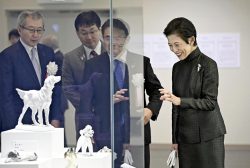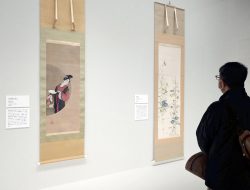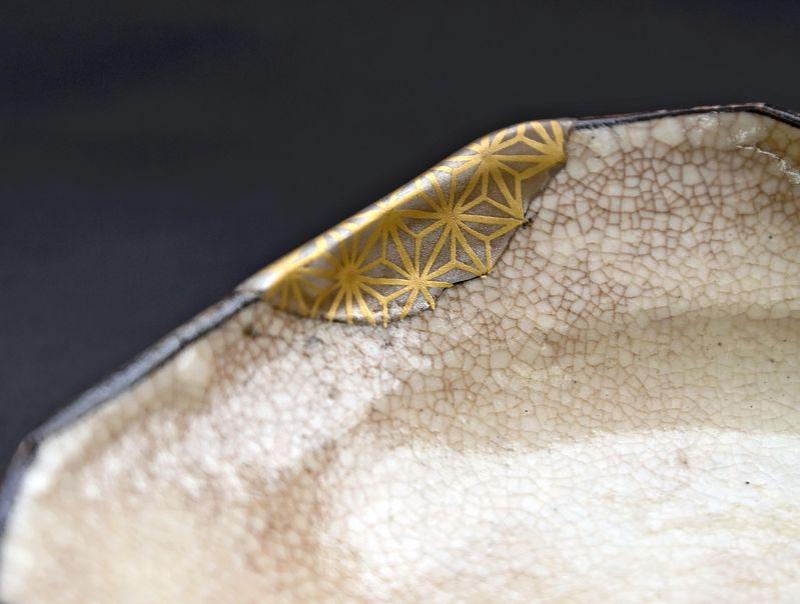
An example of kintsugi ceramic repair work by Yuzo Eto
13:01 JST, March 24, 2022
Kintsugi, a traditional technique that uses lacquer and gold powder to repair cracked or chipped ceramics, is enjoying a renaissance among amateur artisans.
As people spend more time at home due to the novel coronavirus pandemic, some have been reassessing the uses and importance of their possessions.
Kintsugi is thought to have originated in the Muromachi period (1336-1573), accompanying a rise in popularity of the tea ceremony. As part of the kintsugi process, the damaged parts of a ceramic piece are glued together or filled with lacquer and the seams are then decorated with gold powder. If the humidity and other conditions are right, lacquer can be even stronger than adhesives, allowing items to be used long after being repaired.

Lacquer is brushed onto a dish.
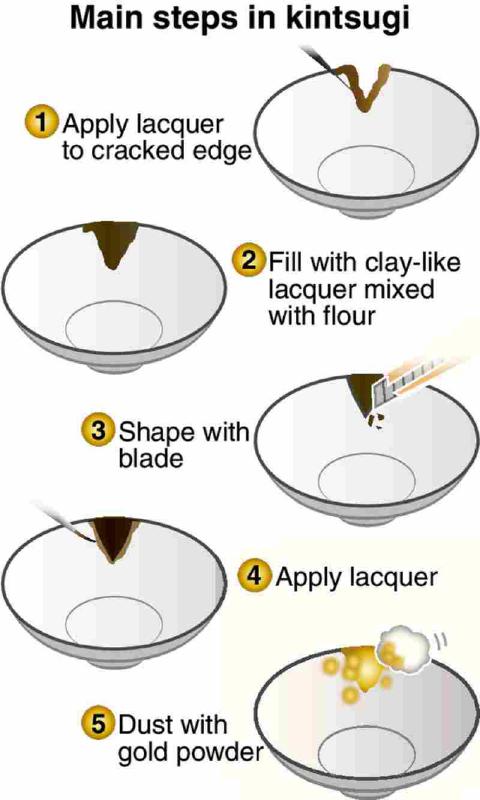
The Tsutsumi Asakichi Urushi lacquer shop in Kyoto, which has been trading since the Meiji era (1868-1912), began selling home-use kintsugi kits for ¥13,750 in March 2019. The kits contain tubes of lacquer and gold powder as well as gloves to protect users’ hands from the lacquer.
As of January 2020, the shop had sold only a few sets a month, but sales took off in February following the arrival of the coronavirus. The store also posted online videos featuring a young lacquer artist explaining how to use the kits. Currently, the shop sells between 100 and 200 kits each month.
“People have fewer opportunities to use lacquerware in their daily lives, so we hope to provide them with a chance to experience the wonderful culture of repair and the natural materials involved,” a representative of the shop said.
Tokyu Hands variety stores also sell kintsugi sets aimed at novices, priced in the ¥6,000-¥8,000 range. Sales of the kits have nearly tripled since April 2020, compared to pre-pandemic figures.
Kintsugi has featured in women’s magazines and served as the topic of multiple books. The technique even formed part of the plot in a 2020 TV drama starring the late Haruma Miura.
Courses that teach kintsugi are also gaining in popularity. Yuzo Eto, a lacquer artist from Himeji, Hyogo Prefecture, who worked on the restoration of Kasugataisha shrine in Nara, teaches kintsugi at about 20 locations in Hyogo and Osaka prefectures. He has become more and more busy since he started teaching about seven years ago. Now, almost all his classes are full.
In November, eight women took part in one of his classes at the Co-op Culture Seikatsu-Bunka Center in Kobe. Eto, 39, provided personalized instructions, such as advising one woman to put more lacquer on the tip of her brush. A chorus of happy voices rang out when the students dusted the finished objects with gold powder.
One student, Makiko Kimura, a homemaker in Itami, Hyogo Prefecture, was restoring a small serving dish used by her late mother. “It’s wasn’t expensive, but I didn’t want to throw it away just because it was cracked,” said Kimura.
Eto added: “Another charming aspect of kintsugi is that the items transform into something new. If more people repair things, it will help raise awareness of the SDGs [Sustainable Development Goals] and help reduce waste.”
Precious objects among kintsugi ceramics
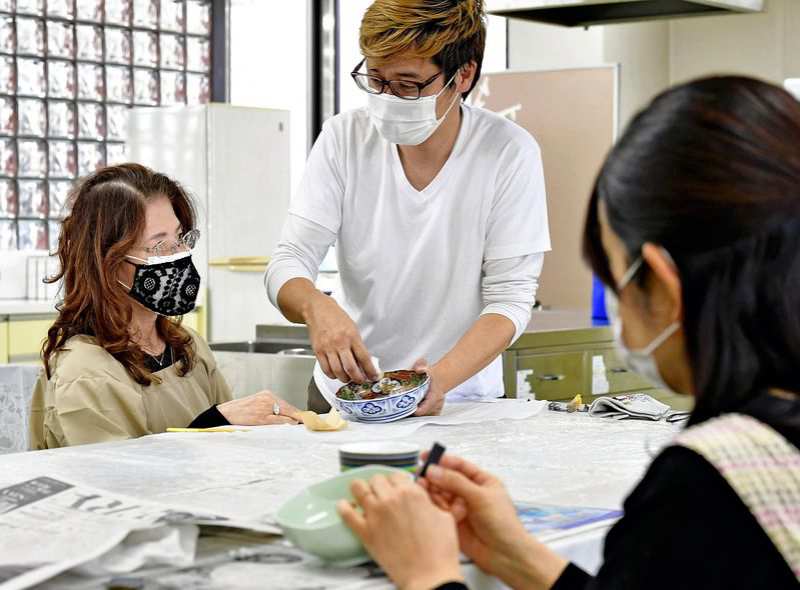
Lacquer artist Yuzo Eto, center, teaches kintsugi to students in Kobe.
Some kintsugi objects are considered to have high artistic value. For example, Hon’ami Koetsu (1558-1637) used kintsugi to repair cracks that occurred during the firing of a red raku ware tea bowl named Seppo.
The bowl, which is owned by the Hatakeyama Memorial Museum of Fine Art in Tokyo, is an important cultural property.
The bowl’s seams have been likened to a thawing mountain stream, and the drinking vessel figures among Koetsu’s seven most famous works.
It is thought the ceramic tea bowl named Tsutsuizutsu — also an important cultural property — was repaired after Toyotomi Hideyoshi’s retainer dropped it, breaking it into five pieces.
Created by an unknown artist, the bowl was owned by Toyotomi (ca 1537-1598) and is now part of a private collection.
Legend has it that Furuta Oribe (1543-1615) — known as the world’s greatest tea master following the death of Sen no Rikyu (1522-1591) — broke one of his own tea bowls and repaired it using lacquer: One of Oribe’s extant bowls exhibits cross-shaped seams.
Kintsugi bowls are preferred for the Nagori no Chaji tea ceremony held around October after summer-use drinking vessels have been put away.
It is said that a sense of yearning for the passing season fits well with the use of kintsugi tea bowls because they evoke the passage of time.
"Culture" POPULAR ARTICLE
-

Van Cleef & Arpels Dazzles with Art Deco Artisanry at Tokyo Exhibit
-

Disney’s ‘Twisted-Wonderland’ Animated Series Puts Villains in Spotlight: New Show Features School Inspired by Classic Disney Films
-

Japan Plans to Distribute Manga Overseas Via New Platform
-

Ayumi Hamasaki’s Shanghai Concert Canceled Day Before Schedule as Part of Beijing Backlash
-

‘The World Masterpiece Theater Series’ Celebrates 50 Years; Animator Looks Back on Creating Anime Classics
JN ACCESS RANKING
-

Tokyo Economic Security Forum to Hold Inaugural Meeting Amid Tense Global Environment
-

Keidanren Chairman Yoshinobu Tsutsui Visits Kashiwazaki-Kariwa Nuclear Power Plant; Inspects New Emergency Safety System
-

Imports of Rare Earths from China Facing Delays, May Be Caused by Deterioration of Japan-China Relations
-

University of Tokyo Professor Discusses Japanese Economic Security in Interview Ahead of Forum
-

Japan Pulls out of Vietnam Nuclear Project, Complicating Hanoi’s Power Plans



